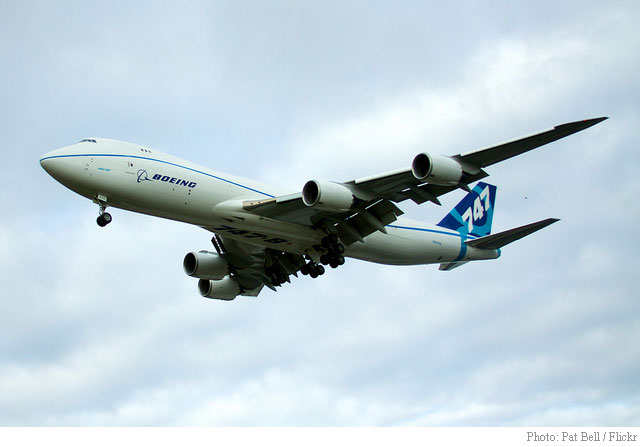
The Boeing 747’s first commercial flight did not get off to an auspicious start.
That inaugural Pan Am voyage from New York’s John F. Kennedy International Airport to London was supposed to depart on the evening of Jan. 21, 1970. Engine trouble grounded the aircraft at the last minute, forcing Pan Am to wheel out a second copy of the brand-new jet. The flight took off six hours late.
In its first few years, the 747 survived a series of mechanical problems, a troubled economy, an Arab oil embargo that sent operating costs soaring, and the trials and errors of airlines that were trying to figure out how to profitably fly a jet that carried more than twice as many passengers as the typical airliner of its day but which cost much more to operate.
Whatever the 747 lacked in efficiency, it made up in pizzazz. From its christening by First Lady Pat Nixon to its upstairs piano lounge, the plane – dubbed the “Queen of the Skies” by its marketers – represented the peak of air travel’s glamour age. Yes, the supersonic Concorde came along just six years later, providing a faster and pricier way to get to Europe, but the Concorde was neither an especially comfortable nor practical mode of transportation. For creature comfort and carrying capacity, the 747 had it beat.
I first became aware of the 747 in the summer of 1970. The hit movie that summer was “Airport,” the melodrama starring Burt Lancaster and Dean Martin, in which a suicidal husband detonates a bomb in the lavatory of a plane above the Atlantic, hoping his widow will collect on some newly issued insurance. (Apparently, the bomber was unaware that life insurance policies have a two-year contestability period.) Though the story takes place aboard an everyday Boeing 707, the film’s fictitious Trans Global Airlines had big plans to introduce the new 747. Though I was only 12 that summer and still years away from my first taste of air travel, I knew the 747 was, literally, something really big.
And it was. Despite its somewhat choppy takeoff, the 747 became the benchmark for spacious, reliable long-distance travel. The piano bars and spiral staircases of the early models soon disappeared, replaced by more efficient business and economy seating after deregulation made air travel more of a commodity. In Asia, airlines sometimes configured the 747 to hold more than 500 passengers (typical capacity elsewhere ranged from 400 to around 450) and continued to use the plane on shorter-haul domestic flights. New 747s came along that stretched the cabin and adopted more modern technology developed for Boeing’s newer models. With four engines and ultra-redundant systems, the 747 compiled an enviable safety record. It was a flying Titanic, soaring safely beyond the reach of any iceberg.
It remained the largest-capacity passenger aircraft for more than 36 years, until the Airbus A380 eclipsed it in 2007. But when its fall finally came, the 747 fell hard. The A380 is almost a different class of vessel, double-decked for its entire length, its four engines capable of carrying more than 850 passengers at a time in an all-economy configuration. The interior space of the A380 is more than 40 percent larger than that of a 747. If it were American-made, I am sure an A380 would be flying as Air Force One today.
It is not the A380, however, that poses the greatest threat to the 747’s reign as queen of the skies. A new generation of not quite so big, yet much more fuel efficient, twin-engine jets like the new 787 Dreamliner, the 1990s-vintage Boeing 777, and the Airbus A340- and A350-series aircraft are far more popular than the super-jumbos. They burn much less fuel and can fly profitably with only a couple of hundred passengers aboard. They are suitable for long-haul domestic flights as well as international routes, so they are more easily reassigned to cover seasonal fluctuations in traffic.
At its peak, Boeing (BA) produced more than 60 747s every year – rolling them off the production line at an average pace of more than one each week. The Los Angeles Times reported recently that Boeing plans to slow 747 production to just 18 aircraft for the year in 2014, down from 21 currently.
Every airplane has a “stall speed,” below which there is simply not enough lift to keep the machine from falling to earth. A production line has a stall speed too – a speed below which it is not profitable to dedicate the supply chain and labor resources needed to sustain it. It sounds as though the 747 has just about reached it.
Soon this remarkable machine, designed by men who carried slide rules, will surrender her position at the head of the fleet. But she will have carried us two decades into the Internet era, and to many other places. It has been a great ride.
- Bulenox: Get 45% to 91% OFF ... Use Discount Code: UNO
- Risk Our Money Not Yours | Get 50% to 90% OFF ... Use Discount Code: MMBVBKSM
Disclaimer: This page contains affiliate links. If you choose to make a purchase after clicking a link, we may receive a commission at no additional cost to you. Thank you for your support!


Leave a Reply